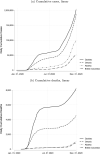The short-term economic consequences of COVID-19: Occupation tasks and mental health in Canada
- PMID: 38607895
- PMCID: PMC9111645
- DOI: 10.1111/caje.12543
The short-term economic consequences of COVID-19: Occupation tasks and mental health in Canada
Abstract
In this paper, we study the effect of COVID-19 on the labour market and reported mental health of Canadians. To better understand the effect of the pandemic on the labour market, we build indexes for whether workers: (i) are relatively more exposed to disease, (ii) work in proximity to co-workers, (iii) are essential workers and (iv) can easily work remotely. Our estimates suggest that the impact of COVID-19 was significantly more severe for workers that work in proximity to co-workers and those more exposed to disease who are not in the health sector, while the effects are less severe for essential workers and workers that can work remotely. Last, using the Canadian Perspective Survey Series, we observe that reported mental health is significantly lower among some of the most affected workers such as women and less-educated workers. We also document that those who were absent from work because of COVID-19 are more concerned with meeting their financial obligations and with losing their job than those who continue working outside their home.
Conséquences économiques de la COVID‐19 à court terme : tâches professionnelles et santé mentale au Canada. Dans cet article, nous étudions les répercussions de la COVID‐19 sur le marché de l'emploi et la santé mentale déclarée des Canadiens. Afin de mieux comprendre les effets de la pandémie sur le marché du travail, nous avons développé des indices permettant de déterminer si les travailleurs : 1) sont relativement plus exposés à la maladie; 2) exercent leur activité à proximité de leurs collègues; 3) sont essentiels; 4) peuvent facilement travailler à distance. D'après nos estimations, les conséquences de la COVID‐19 se sont avérées nettement plus sévères chez les travailleurs exerçant à proximité de leurs collègues ainsi que les professionnels (hors secteur médical) davantage exposés à la maladie, mais moins importantes chez les travailleurs essentiels et les télétravailleurs. Enfin, en nous appuyant sur l'une des enquêtes sur les perspectives canadiennes, nous observons que la santé mentale déclarée est nettement inférieure chez les travailleurs les plus touchés, notamment les femmes et les travailleurs moins instruits. Nous montrons également que les personnes écartées de leur travail en raison de la COVID‐19 se soucient davantage du respect de leurs obligations financières et de la perte de leur emploi par rapport à celles qui ont pu continuer à travailler hors de leur domicile.
© 2021 Canadian Economics Association.
Figures








References
-
- Adams‐Prassl, A. , Boneva T., Golin M., and Rauh C. (2020) “Inequality in the impact of the coronavirus shock: Evidence from real time surveys,” Journal of Public Economics 189, 104245
LinkOut - more resources
Full Text Sources
